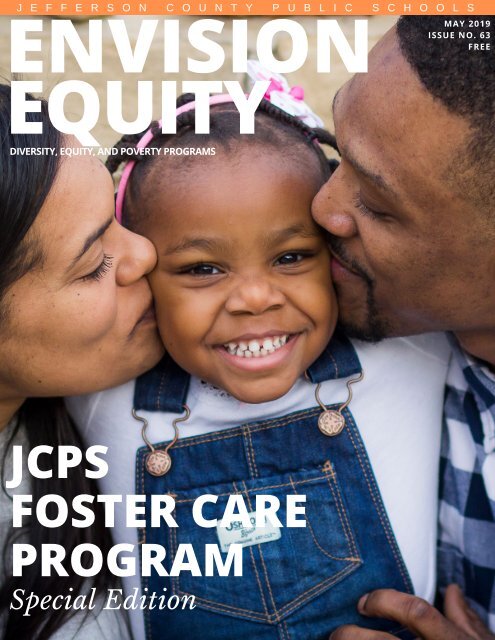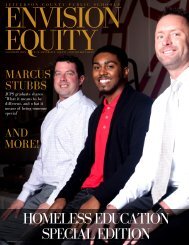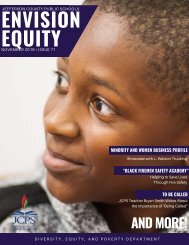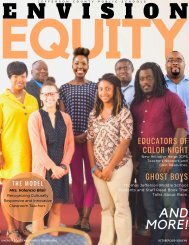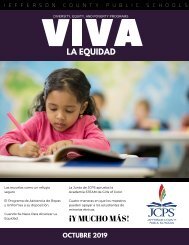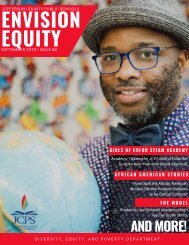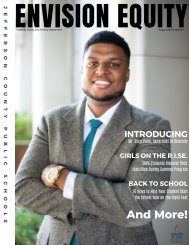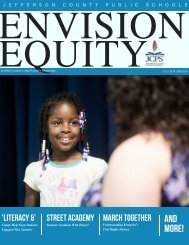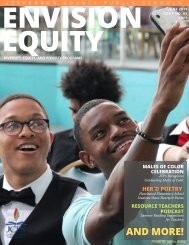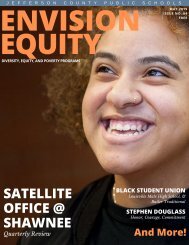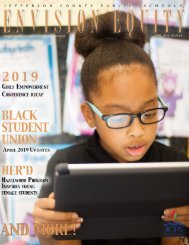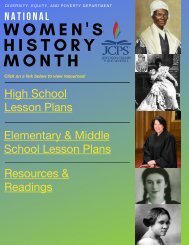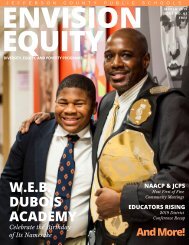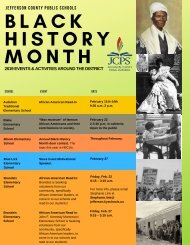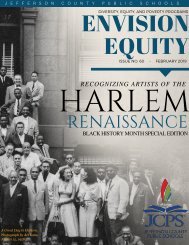May 2019 Foster Care Special Edition
You also want an ePaper? Increase the reach of your titles
YUMPU automatically turns print PDFs into web optimized ePapers that Google loves.
J E F F E R S O N C O U N T Y P U B L I C S C H O O L S<br />
ENVISION<br />
EQUITY<br />
DIVERSITY, EQUITY, AND POVERTY PROGRAMS<br />
MAY <strong>2019</strong><br />
ISSUE NO. 63<br />
FREE<br />
JCPS<br />
FOSTER CARE<br />
PROGRAM<br />
<strong>Special</strong> <strong>Edition</strong><br />
1<br />
Photo, Getty Images
<strong>May</strong> is National <strong>Foster</strong> <strong>Care</strong> Month, and<br />
we at JCPS wanted to take the time to<br />
honor this special group of students.<br />
Introduction<br />
By Lindsay Bale—JCPS <strong>Foster</strong> <strong>Care</strong> Liaison<br />
Did you know that nationally, there are over<br />
400,000 children in foster care? In the state of<br />
Kentucky, we have 9739 foster youth and in<br />
Jefferson County alone we have 1,177 children in<br />
foster care according to the Jefferson <strong>Foster</strong> <strong>Care</strong><br />
Fact Sheet (April, <strong>2019</strong>). That’s enough children<br />
to fill an entire high school!<br />
Students in foster care face numerous challenges<br />
that can affect their educational attainment and<br />
experiences. In the 2017-2018 school year, data<br />
was collected and students in foster care were<br />
listed as a group on the school report card for the<br />
first time. According to data published by the<br />
Kentucky Department of Education, only 29.7%<br />
2<br />
Continue on next page
ENVISION EQUITY MAY <strong>2019</strong><br />
of JCPS elementary students in foster care scored proficient in reading, 32.4% of middle school<br />
students, and 22.2% of high school students in foster care. Math scores paint an even more<br />
concerning picture, with only 5.7% of high school students in foster care scoring proficient/<br />
distinguished.<br />
National data paints a similar picture of the achievement gaps that we are working diligently to<br />
close. Some of the data indicates that students in foster care have increased rates of<br />
suspensions, absences, and special education services. In addition, students in foster care<br />
experience school instability at much higher rates than their peers. In the following pages, you<br />
will get a clearer picture of the national data and the local data we have begun to collect, and<br />
obtain a greater understanding of the urgent need to provide additional supports and services<br />
for this vulnerable group of students.<br />
We have been working very hard over the past year to bring awareness to the needs of our<br />
students in foster care and to provide equitable access to opportunities that will help them<br />
achieve. We are proud of the work we have done, and continue to focus on opportunities for<br />
growth.<br />
In this edition of Envision Equity, you will learn some<br />
facts about foster care and education, strategies that are<br />
effective in working with foster youth, programs and<br />
services that have been offered to students in foster care<br />
in JCPS, how to care for yourself as you engage in this<br />
difficult but rewarding work, and resources that are<br />
available to help foster youth garner success.<br />
We know the number one way to change the trajectory<br />
for a child who has experienced trauma is a positive adult<br />
relationship. Please consider becoming a mentor, foster<br />
parent, advocate, trauma-informed educator, CASA<br />
volunteer, life coach, or serving in any role that will help<br />
our foster youth reach their full potential and become all<br />
they are destined to be!<br />
Lindsay Bale, MSSW, CSW<br />
JCPS <strong>Foster</strong> <strong>Care</strong> Liaison<br />
You can reach me at 485-6358 or by email at<br />
Lindsay.bale@jefferson.kyschools.us<br />
3
<strong>Foster</strong> Youth Achievement Program Successes<br />
• Over 200 students in foster care have received transportation services from<br />
JCPS to maintain school stability in the 2018-<strong>2019</strong> school year (75 students in<br />
2017-2018).<br />
• Students in foster care are now identified in the Infinite Campus database<br />
which is updated monthly. This allows schools to ensure they have appropriate<br />
contact information for students and also allows schools to target students for<br />
services and activities that will be beneficial for them.<br />
• The JCPS <strong>Foster</strong> <strong>Care</strong> Handbook was written and published (https://<br />
drive.google.com/file/d/1C1peVBijF_jjgNZUs3QNOL6wggrqLO-m/view)<br />
• Collaborative conference “Promoting Educational Resilience for Students in<br />
<strong>Foster</strong> <strong>Care</strong>” held in conjunction with Kentucky Youth Advocates. Over 85<br />
attendees including foster parents, community partners, and educators came<br />
together to learn about the Every Student Succeeds Act (ESSA) regulations for<br />
students in foster care, self-care, and trauma-informed practices.<br />
• Professional Development sessions have been provided to include information<br />
on the Every Student Succeeds Act (ESSA), Understanding Indicators of Child<br />
Abuse and Neglect, and Adverse Childhood Experiences and <strong>Foster</strong> <strong>Care</strong>.<br />
• Over 75 social workers, 80 foster parents, and 500 educators have received<br />
training on the protections of students in foster care under ESSA.<br />
• Policies were passed by the Jefferson County Board of Education and added to<br />
JCPS Policy Manual to include policies and procedures for students in foster<br />
care.<br />
• Registrar handbook and Pupil Personnel handbook were updated to include<br />
procedures for students in foster care.<br />
• <strong>Foster</strong> <strong>Care</strong> webpage was developed and added to the JCPS website.<br />
• Four foster parents have been added to the Title 1 Parent Advisory Council .<br />
• Students in foster care are represented on the Superintendent’s Student<br />
Advisory Council.<br />
• Spring Break Camp at the Louisville Zoo allowed for 18 students in foster care<br />
to have a fun, educational Spring Break experience.<br />
• Step Up for Students collected hygiene items for students in foster care for<br />
foster care awareness month in <strong>May</strong> 2018 and will collect again in <strong>May</strong> <strong>2019</strong>.<br />
4<br />
Continue on next page
• A <strong>Special</strong> <strong>Edition</strong> of Envision Equity was created for <strong>Foster</strong> <strong>Care</strong> Awareness month<br />
in <strong>May</strong> 2018, and again in <strong>May</strong> <strong>2019</strong>.<br />
• Back to School Bash held in partnership with Aetna Better Health and True Up.<br />
Over 85 students who attend State Agency Schools received school supplies.<br />
• JCPS was able to provide over 1200.00 in gift cards for students in foster care at<br />
a collaborative holiday celebration.<br />
• The FAFSA Challenge with school counselors allowed 17 seniors in foster care to<br />
complete their FAFSA within the first 30 days of eligibility.<br />
• 27 students in foster care attended the Equity in Higher Education Conference at<br />
the University of Louisville and 3 received scholarships toward higher education.<br />
• Students in foster care have received new uniforms and shoes, and gently used<br />
clothing, coats, etc. from the 15th District PTA Clothing Assistance Program.<br />
• Graduation celebration held in collaboration with DCBS and Private Child <strong>Care</strong><br />
agencies to celebrate the 28 seniors in foster care who graduated in 2018 and a<br />
celebration will be held again in <strong>2019</strong>.<br />
• As part of the FACES of JCPS video collection, a video for foster parents was<br />
recorded to inform them of the services available to students in foster care.<br />
• VOICES of Students in <strong>Foster</strong> <strong>Care</strong> audio recording was developed for training<br />
purposes. This video incorporated interviews of 6 JCPS students in foster care<br />
and the importance of educational stability.<br />
• Students in foster care have been provided with access to out-of-school time<br />
activities, including literacy and programs, tutoring at the JCPS satellite office,<br />
Girls on the Rise, and more.<br />
• College and <strong>Care</strong>er Fair will be held <strong>May</strong> 21, <strong>2019</strong> in collaboration Boys and Girls<br />
Haven, Youth Build Louisville/Summer Works, and other child welfare and<br />
advocacy agencies to allow students in foster care to explore a variety of<br />
colleges and careers.<br />
• 1 mile walk to be held <strong>May</strong> 18, <strong>2019</strong> at Shawnee Park to bring awareness to the<br />
needs of various groups of students, including students in foster care.<br />
5
Professional Development Offerings Provide JCPS<br />
Staff with Tools to Support <strong>Foster</strong> Youth<br />
By Lindsay Bale—JCPS <strong>Foster</strong> <strong>Care</strong> Liaison<br />
Over the past year, we have<br />
made an intentional effort to<br />
offer professional<br />
development sessions that<br />
will provide teachers with the<br />
skills necessary to work with<br />
our students in foster care<br />
and students who have<br />
experienced trauma. Not only<br />
have we trained educators on<br />
the importance of school<br />
stability and The Every<br />
Student Succeeds Act, but we<br />
have also offered a variety of<br />
sessions to help teachers create a culture and climate that is safe and welcoming for our students.<br />
By partnering with the U of L Center for Promoting Recovery and Resilience, staff have received<br />
invaluable information on Adverse Childhood Experiences and <strong>Foster</strong> <strong>Care</strong> and Best Practices for<br />
Establishing a Trauma Informed Classroom. These sessions were designed by the CPRR specifically<br />
for JCPS educators. The trainings were engaging, interactive, and participants left with information<br />
that will allow them to be better prepared to work with students experiencing trauma. Staff who<br />
attended the initial session, ACES and <strong>Foster</strong> <strong>Care</strong>, learned about the basics of trauma and how to<br />
identify students who have experienced trauma. They were also challenged to dive deeper into<br />
behavioral issues to determine “what has happened” to a student as opposed to “what is wrong”<br />
with a student. Following this session, participants reported that they would like more specific<br />
information about what they can do to help our students who have experienced trauma. This led<br />
to the development of the Best Practices PD offering. In this session, participants learned the 6<br />
core elements of trauma informed practices: safety, trustworthiness and transparency, peer<br />
support, collaboration and mutuality, empowerment, voice, and choice, and cultural, historical,<br />
and gender Issues. Educators were able to see examples of classrooms, schools, and individuals<br />
who are doing an exceptional job at creating a trauma informed climate. In addition, educators<br />
6
were able to reflect on current practices at their schools on both an individual level and school<br />
level, and discuss strengths and areas of growth in each of the 6 core elements.<br />
In addition to these offerings Dr. Melissa Currie, Medical Director and Division Chief at Kosair<br />
Charities Division of Pediatric Medicine, shared her expertise with participants to help identify<br />
signs and symptoms of abuse and neglect, and also appropriate reporting of concerns. She<br />
provided a session specifically for ESL bilingual educators and a session was also offered<br />
districtwide. Dr. Currie provided real examples of patients she has seen in the emergency<br />
department. She also provided valuable information on differentiating between neglect and<br />
poverty. She also explained that child maltreatment happens across all ethnic, social, and<br />
economic groups and there is not one group that is exempt from child maltreatment. Dr. Currie<br />
also discussed the importance of recognizing our own biases when deciding whether to report<br />
abuse or neglect.<br />
All sessions received very positive feedback and many participants left these sessions wanting to<br />
know more! Outcomes for students depend not only on students making progress, but also by the<br />
district providing equitable access to opportunities, and helping educators develop the tools that<br />
will help all students be successful. We are committed to improving the whole system of support<br />
for our students, and offering enriching professional development sessions is just one way to make<br />
that happen!<br />
7
JCPS <strong>Foster</strong> <strong>Care</strong> Data<br />
Total Number of JCPS Students in <strong>Foster</strong><br />
<strong>Care</strong> as of April <strong>2019</strong> = 945<br />
Number of <strong>Foster</strong> Youth in<br />
Grade Level<br />
1<br />
0 237 474 711 948<br />
JCPS <strong>Foster</strong> Youth by Ethnicity<br />
Early Childhood Elementary Middle High<br />
School Stability<br />
2018-<strong>2019</strong><br />
Hispanic African American Caucasian 2+ races<br />
1 enrollment 2 enrollments 3 enrollments<br />
4+ enrollments<br />
School Setting<br />
<strong>Foster</strong> Youth in Non-Traditional School Settings<br />
<strong>Foster</strong> youth in Traditional School Settings (A-1 schools)<br />
8
KPREP Data for JCPS<br />
Students in <strong>Foster</strong><br />
<strong>Care</strong> 2017-2018<br />
Data taken from Kentucky Department of Education website<br />
Data is limited due to only reporting on schools with over 10 students in foster care for the<br />
purpose of confidentiality<br />
Scores for students in State Agency Programs are reported as state data and not Jefferson<br />
County data<br />
9
ENVISION EQUITY MAY <strong>2019</strong><br />
10
ENVISION EQUITY MAY <strong>2019</strong><br />
Legislation to Support<br />
Students in <strong>Foster</strong> <strong>Care</strong><br />
By Lindsay Bale, JCPS <strong>Foster</strong> <strong>Care</strong> Liaison<br />
As legislators continue to recognize<br />
the unique needs of children in foster<br />
care, State and Federal agencies<br />
have passed several pieces of<br />
legislation to support the educational<br />
achievement and experiences of youth in<br />
foster care. Some of these federal laws<br />
include the <strong>Foster</strong>ing Connections Act,<br />
Uninterrupted Scholars Act (USA), and the<br />
Every Student Succeeds Act (ESSA). In the<br />
state of Kentucky, House Bill 33 (KRS<br />
620.146) and House Bill 527 are bills that<br />
were passed to support the educational<br />
needs of students in foster care. In addition,<br />
laws were passed in the most recent<br />
legislative session that provides supports for<br />
families and caregivers, and provides foster<br />
youth with a Bill of Rights. Below is an<br />
overview of each law:<br />
<strong>Foster</strong>ing Connections: This federal law was<br />
passed in 2008. This law requires child<br />
welfare agencies to ensure that a student in<br />
foster care remains in the same school they<br />
were enrolled in at the time of placement<br />
into foster care.<br />
Uninterrupted Scholars Act: This law was<br />
passed in 2013 and amended FERPA to allow<br />
child welfare workers access to educational<br />
records of youth in their care without<br />
parental consent.<br />
Every Student Succeeds Act: This law was<br />
passed in 2015 and requires the<br />
collaboration of child welfare agencies and<br />
educational agencies to ensure educational<br />
stability for youth. This law allows students<br />
in foster care to remain in their school of<br />
origin when it is in their best interest, with<br />
transportation provided. In addition, it<br />
allows for students to be immediately<br />
enrolled in a new school, even when records<br />
that are normally required to enroll in school<br />
are not available. Lastly, it requires that<br />
educational agencies report annually on<br />
student achievement and graduation rates<br />
for foster youth.<br />
House Bill 33 (KRS 620.146): This law was<br />
passed in 2017 and requires CHFS social<br />
workers to notify school personnel of people<br />
who are authorized to contact the student at<br />
11<br />
Continue on next page
ENVISION EQUITY MAY <strong>2019</strong><br />
school or remove the student from school grounds. This is required when an order for<br />
emergency, temporary, or permanent custody has been received by CHFS.<br />
House Bill 527 (KRS 199.802): This bill was passed and signed by the governor in 2018.<br />
This bill codifies ESSA into Kentucky state law. This bill requires that CHFS place foster<br />
youth in their same school district when practicable. It also requires social workers to<br />
make a determination as to whether it is in a child’s best interest to remain in his/her<br />
school of origin. It maintains that the cost of transportation cannot be a factor in<br />
determining the best interest for a child’s school placement, and that reasonable<br />
transportation must be offered for a child to remain in the school of origin. If it is<br />
determined to be in a student’s best interest to change schools, school districts must<br />
establish procedures for immediately enrolling a student in the new school.<br />
House Bill 1: This bill was passed in the 2018 legislative session and seeks to keep kids<br />
safe and improve how Kentucky responds to and supports families. It addresses policy<br />
change within the courts, within the Cabinet for Health and Family Service (CHFS), and<br />
within the organizations and agencies serving kids who come to the attention of child<br />
protective services to ensure all the parts of the child welfare system and related policies<br />
work together and produce better outcomes for all involved.<br />
House Bill 158: This bill was passed in the most recent legislative session. It aligns state<br />
law with the Family First Prevention Services Act and establishes a <strong>Foster</strong> Youth Bill of<br />
Rights.<br />
House Bill 2: Passed in the <strong>2019</strong> legislative session, this bill establishes the development<br />
of supportive services for kinship and fictive kin caregivers, including, but not limited to,<br />
monetary and respite supports. It would also establish a reporting mechanism to track<br />
and analyze data on relative and fictive kin caregiver placements.<br />
2008<br />
<strong>Foster</strong>ing<br />
Connections<br />
2015 Every<br />
Student<br />
Succeeds Act<br />
2018 KY<br />
House Bill<br />
527<br />
<strong>2019</strong> KY<br />
House Bill<br />
158<br />
2013<br />
Uninterrupte<br />
d Scholars<br />
Act<br />
2017 KY<br />
House Bill 33<br />
(KRS<br />
620.146)<br />
2018 KY<br />
House Bill 1<br />
<strong>2019</strong> KY<br />
House Bill 2<br />
12
ENVISION EQUITY MAY <strong>2019</strong><br />
<strong>Foster</strong> youth Bill of Rights<br />
By Joshua Degnan, President —Voices of the Commonwealth<br />
“<br />
A child who is placed<br />
in foster care shall be<br />
considered a primary<br />
partner and a member of<br />
a professional team. A<br />
foster child, as the most<br />
integral part of the<br />
professional team, shall<br />
have the following rights”<br />
<strong>Foster</strong> Youth Bill of Rights;<br />
KY House Bill 158. This statement is profoundly important to any youth who finds<br />
themselves in foster care because it shows hope and that times are changing. On March 19 th<br />
of <strong>2019</strong> Governor Bevin signed House Bill 158 into law. This Bill covered a substantial<br />
number of topics that affect youth who enter into the state’s system such as background<br />
checks for caretakers, parental rights, and a bill of rights for foster youth. It is the latter of<br />
these topics that myself as well as a number of other youth from across the state rallied<br />
behind and advocated for because we knew the momentum that it would carry.<br />
I have had the privilege of traveling across the county and talking to young people who have<br />
gone through foster care. Their stories of trial and triumph are as diverse as they are but one<br />
common theme tends to arise; feeling powerless and having no control over their lives while<br />
under the care of the state. I myself experienced this as I went through my years in care and<br />
13<br />
Continue on next page
ENVISION EQUITY MAY <strong>2019</strong><br />
this feeling came from a general lack of knowledge about my own life and the plans made<br />
for me. Young people are frequently having decisions made about them on matters that will<br />
have an impact on the direction of their life without their knowledge. One such decision is<br />
their residency. Youth in care are moved from place to place sometimes at a very high rate<br />
and with very little notice. I have talked to youth who have been moved fifteen times or<br />
more. This constant displacement directly impacts being able to develop friendships,<br />
growing in their community, and the ability to develop in a healthy manor.<br />
I myself experienced this when I was twenty. I was preparing to leave the state’s care at the<br />
age of twenty-one and had begun to create success for myself. I had done well in college, I<br />
had begun my career, and was well on the way to creating a life for myself. Then over six<br />
months prior to when I expected to move out onto my own that process was sped up<br />
drastically! When my state worker came to meet with me I was told that I had done too well<br />
for myself and because of that it was going to be requested that I be removed from the care<br />
of the state. That is exactly what resulted, after meeting with the judge I was told I had two<br />
weeks left before I was to be removed from care. This meant very little time to secure a new<br />
residence and move every earthly belonging I had. My hope is that by involving youth in<br />
these decisions and recognizing them as the most integral part of the team making these<br />
choices that no one will have to experience such a drastic change under such a short notice.<br />
The <strong>Foster</strong> Youth Bill of Rights continues to support the health and wellbeing of youth in care<br />
in several ways. It specifically points out basic human needs such as adequate food,<br />
clothing, and shelter, rights that all people should have. It then progresses to deeper matters<br />
such as being free from abuse, being free to develop, and to having a stable family. These<br />
three topics will aid the mental health of youth in care. So many have already experienced<br />
trauma and a lack of stability for such an extended period that they can not find peace. My<br />
hope is that this bill of rights will be able to provide young people with some type of<br />
consistency so they can have the opportunity to find themselves and grow to be healthy<br />
14<br />
Continue on next page
ENVISION EQUITY MAY <strong>2019</strong><br />
members of society. I believe the persons who formed this bill of rights had the same vision<br />
as myself because it continues to support that theme.<br />
Normal growth is addressed frequently throughout this bill of rights in a number of ways<br />
such as a stable educational setting, being allowed to participate in extra-curricular<br />
activities, the right to see and speak with family and friends. Young people who grow up out<br />
of care are normally permitted to these rights and foster youth have longed for them for a<br />
long time. I have been told time and time again by individuals in care that they are so heavily<br />
restricted on who they can talk to and see that they are not able to maintain friendships and<br />
are often incredibly isolated. I hope to see this change as these rights become law.<br />
The one underlying theme that I saw as I read through the bill of rights was hope. Often<br />
enough youth in care do not have any hope and feel lost. I hope that seeing our law makers<br />
recognize the need for these rights in legislation will show that they care about these young<br />
peoples’ futures. Until the day this bill goes into effect youth in foster care legally have no<br />
rights. Policies are in place suggesting these rights exist but those hold no legal standing.<br />
Every member of the Senate and House who voted on this bill was in its favor showing me<br />
that Kentucky cares about its youth!<br />
15
ENVISION EQUITY MAY <strong>2019</strong><br />
<strong>Foster</strong> Youth Bill of Rights<br />
A child who is placed in foster care shall be considered a primary partner and member of<br />
a professional team. A foster child, as the most integral part of the professional team,<br />
shall have the following rights to:<br />
(1) Adequate food, clothing, and shelter;<br />
(2) Freedom from physical, sexual, or emotional injury or exploitation;<br />
(3) Develop physically, mentally, and emotionally to his or her potential;<br />
(4) A safe, secure, and stable family;<br />
(5) Individual educational needs being met;<br />
(6) Remain in the same educational setting prior to removal, whenever possible;<br />
(7) Placement in the least restrictive setting in close proximity to his or her home that<br />
meets his or her needs and serves his or her best interests to the extent that such<br />
placement is available;<br />
(8) Information about the circumstances requiring his or her initial and continued<br />
placement;<br />
(9) Receive notice of, attend, and be consulted in the development of case plans during<br />
periodic reviews;<br />
(10) Receive notice of and participate in court hearings;<br />
(11) Receive notice of and explanation for changes in placement or visitation agreements;<br />
(12) Visit the family in the family home, receive visits from family and friends, and have<br />
telephone conversations with family members, when not contraindicated by the case<br />
plan or court order;<br />
(13) Participate in extracurricular, social, cultural, and enrichment activities, including but<br />
not limited to sports, field trips, and overnights;<br />
(14) Express opinions on issues concerning his or her care or treatment;<br />
(15) Three (3) additional rights if he or she is age fourteen (14) years or older. These<br />
additional three (3) rights are the right to:<br />
16<br />
Continue on next page
ENVISION EQUITY MAY <strong>2019</strong><br />
(a) Designate two (2) additional individuals to participate in case planning conferences<br />
or periodic reviews, who are not the foster parent or his or her worker, and who may<br />
advocate on his or her behalf. The cabinet, child23 caring-facility, or child-placing agency<br />
may reject an individual with reasonable belief that the individual will not act<br />
appropriately on the child’s behalf;<br />
(b) Receive a written description of the programs and services that will help prepare him<br />
or her for the transition from foster care to successful adulthood; and<br />
(c) Receive a consumer report yearly until discharged from care and to receive assistance<br />
in interpreting and resolving any inaccuracies in the report, pursuant to 42 U.S.C. sec.<br />
675(5)(I); and<br />
5 (16) Receive, free of charge when he or she is eighteen (18) years or older and preparing<br />
to exit foster care by reason of attaining the age of eighteen (18) years old, the following:<br />
(a) An official birth certificate;<br />
(b) A Social Security card;<br />
(c) Health insurance information;<br />
(d) A copy of the child’s medical records; and<br />
(e) A state-issued identification<br />
17
ENVISION EQUITY MAY <strong>2019</strong><br />
My Public School Experience<br />
as a Student in <strong>Foster</strong> <strong>Care</strong><br />
By Tamara Vest<br />
The adolescent stage is<br />
one of the most critical<br />
stages for young people to<br />
explore their social<br />
environment and develop their<br />
identities. This is one of the<br />
things I learned in my high<br />
school sociology class. For me, I<br />
had a lot of boundaries that<br />
were outside of my control during this time. In the middle of my adolescence at the age of<br />
sixteen, I was placed in foster care. It was a really hard transition for me. A few months prior, I had<br />
spent my time in a children’s homeless shelter. A few of my teachers knew what was happening.<br />
They were very supportive and understanding, and they always made time to pull me aside and<br />
make sure that I was doing okay.<br />
When I went into my first foster home, I lost a lot of friends. Being a foster child, there are a lot of<br />
boundaries that keep you from doing things that regular kids do. Much of my social life was<br />
depleted when I was in foster care. I wanted to be on the cheerleading team, and the track team,<br />
but due to lack of proper funding when you are in foster care, I could not afford to join any sport’s<br />
teams. I was in the Advanced Women’s Choir, and if it were not for my amazing choir teacher at<br />
18<br />
Continue on next page
ENVISION EQUITY MAY <strong>2019</strong><br />
the time I would have missed out on several opportunities there as well. Ms. Stohlmann<br />
helped me afford three field trips with the choir. Choir was one of the only places left in my life<br />
where I felt like I belonged. I also lost many friends due to the regulations set by the Cabinet<br />
for Health and Family Services that did not allow their foster kids to stay at another house<br />
unless the adult’s in the home had undergone a background check. Many of my friend’s<br />
parents didn’t like this stipulation and my friends didn’t understand me when I tried to<br />
explain to them that it was out of my control.<br />
During this year I turned seventeen. I wanted to get my permit like any other normal teenager<br />
but there were barriers for that too. The DMV did not allow my foster mother to sign for me to<br />
get my permit, and my social worker was unable to do the job. During this time when I felt I<br />
had no one on my side, aside from my choir teacher, I had developed a relationship with my<br />
school social worker. Ms. Davis helped me obtain many resources that I was lacking at the<br />
time and always had an open door when I needed someone to talk to.<br />
By the beginning of my senior year, I was living in one of the Independent Living Programs for<br />
foster care children who are seventeen or older. I had been accepted into the Opportunity<br />
Middle College program. I took college classes at Bluegrass Community and Technical College<br />
while also finishing my last high school credits that I needed in order to graduate. Leaving my<br />
home school was hard. I had to leave choir but I wanted a better future for myself so I chose to<br />
try and get ahead. In my current situation as a foster youth, I knew that college would be<br />
challenging because I would have to support myself while also paying for college and that’s<br />
why I made the decision to go into the OMC program.<br />
I was starting my senior year in another new environment, with no friends and no support<br />
system for me. It was hard. I missed a lot of classes due to lack of transportation and other<br />
19<br />
Continue on next page
ENVISION EQUITY MAY <strong>2019</strong><br />
circumstances of my living situation. I still managed to pass my college courses that semester<br />
with a 3.0 average and the representatives for OMC were very understanding of my situation.<br />
For my last semester of my senior year, I opted to go through the plato co-op program. I<br />
turned 18 at the beginning of this semester which meant I had aged out of foster care, and had<br />
to live on my own and provide my own housing. This allowed me to have the freedom I needed<br />
to work in order to afford my bills. In this program I could finish the last credit of Biology that I<br />
needed in order to graduate online while working at my job. This meant I did not have to show<br />
up to campus, which was beneficial to me since I did not have a car nor a license. All I needed<br />
was access to internet. Over my winter break, I finished my online school work at a local public<br />
library and I spent the last part of my semester working to afford my own apartment.<br />
During the time I experienced foster care, I missed out on many opportunities that normal<br />
teenagers got to have. I wasn’t able to join clubs and teams that required funding, which hurt<br />
some of my scholarship chances for college. I was not able to go to social events with friends<br />
whenever I liked, and I was unable to obtain my license. Transitioning into foster care, and<br />
being put into a home where I had to live with and trust people that I didn’t know with my<br />
well-being was nerve wracking. Then transitioning into an independent living program where I<br />
learned to support myself while still in high school was challenging. I had no control over<br />
things that happened in my life. It seemed like all of these experiences defined me as lessthan.<br />
One of the things I always had pride in, and that I knew was under my control, and reflected on<br />
me as a person was my school. I always took pride in doing well. I graduated high school with a<br />
3.8 accumulative GPA. Many foster youth do not finish high school, and do not go on to college.<br />
After high school, I went on to college at BCTC in Lexington where I wanted to major in Political<br />
Science and go to law school.<br />
20<br />
Continue on next page
ENVISION EQUITY MAY <strong>2019</strong><br />
After about a year in, I realized it was really difficult to keep up a full-time course load of<br />
studies, work to afford bills and take care of myself while still being blocked by<br />
transportation issues. I had to catch the bus at 6 a.m. for an 8 a.m. class, and I didn’t finish<br />
classes until 3 p.m. I had to catch the bus right after school to be at work on time by 5 p.m.<br />
and worked until 10 or 11 p.m. almost every day. I also was not really enjoying the topic I was<br />
studying.<br />
I decided that I wanted to take the time to figure out what I really wanted for myself, what I<br />
enjoyed and I wanted to get my living situation to stable. After a year and a half of working<br />
different jobs and reflecting on myself, I decided to go back to college at BCTC in <strong>May</strong> of 2017.<br />
Putting all of my experiences together, and thinking about other role models I had in my life,<br />
I decided that Social Work was the right path for me. I took full time summer courses and<br />
continued taking courses throughout the year and the next summer to catch up. I finished<br />
my Associate in Arts degree at BCTC in the fall of 2018.<br />
I was accepted into the College of Social Work at the University of Kentucky and transferred<br />
there for Spring semester of <strong>2019</strong>. I am currently finishing my first semester at UK and plan to<br />
continue the road to my Bachelor’s degree.<br />
In <strong>May</strong> of <strong>2019</strong>, my commencement ceremony from BCTC will take place. I am now a college<br />
graduate. I have also obtained my drivers license as of April <strong>2019</strong>, and I had saved money and<br />
bought my first car.<br />
I am so grateful for how far I have come on my own considering the obstacles that I had to<br />
cross in order to get here. I may not have had the same opportunities as others, but I am<br />
21<br />
Continue on next page
ENVISION EQUITY MAY <strong>2019</strong><br />
grateful for the ones I did have, and the ones that I made for myself. My future goals are to<br />
help advocate for people who feel like they are being marginalized, or that their opinion<br />
doesn’t matter and to help make more opportunities for them. My goal population is to work<br />
with adolescents because that is where my journey started. I would ultimately love to<br />
become a school social worker for a high school. I believe there is a lot of good work that a<br />
school social worker can do since the youth spend half of their lives in our schools.<br />
None of these options would be possible for me if it wasn’t for the few people who supported<br />
me during the initial harder times. Overall I think the public school system is supportive of<br />
foster youth, but there is still much more work to be done. In the future, I would love to see<br />
that foster youth are able to join the same teams as others with or without proper funding.<br />
This may be one of the policies that I will advocate for when I have obtained my career goal<br />
as a school social worker.<br />
22
ENVISION EQUITY MAY <strong>2019</strong><br />
Have No Fear<br />
Transportation is Here<br />
DBy Tonya Clinkscales—Transportation, Jefferson County Public Schools<br />
ue to the hardship each student in foster care endures, it’s the<br />
responsibility of the community, the Cabinet, and the District to<br />
provide educational continuity for the students of Jefferson County<br />
Public Schools. This task at times can be complex, complicated, and<br />
sometimes impossible. Providing transportation outside of a student’s<br />
attendance area, network and/or cluster limits the availability of buses.<br />
Transportation realized our foster care population was expanding and more<br />
students were in need of stability. Even though the laws of foster care allows<br />
students to stay in their school of origin this became a more complex task.<br />
In 2018, the transportation department met with cabinet members of Jefferson County Public Schools<br />
and voiced our concerns, and the responsibility we have for all students of Jefferson County including<br />
foster care students. Transportation was allotted a budget to purchase 6 vans, and 8 buses dedicated<br />
to foster care students. I work with all 13 compounds daily to assist in this task. We are currently<br />
transporting 238 students. I take so much pride in working with each family, as I search high and low<br />
for a bus for each of my students to give them stability, comfort, and some consistency during their<br />
time of hardship. When working for my students, I am diligent in making certain that they receive the<br />
attention and support. I spend time searching each route individually to provide the best, most<br />
effective services to my students. Their education is important regardless of their status or where they<br />
live.<br />
As one who has faced challenges and continues to strive for my personal best, I understand the<br />
importance of community guidance and partnership. Therefore, I am committed to serving my<br />
community through services such as, providing motivational conversations with single mothers and<br />
young ladies, organizing job fairs in the community, contributing business clothing for young ladies<br />
seeking employment, working with The Center for Women and Families to provide necessary items for<br />
families starting over, providing transportation for church functions in the community, as well as<br />
transportation for after school activities for disadvantaged children.<br />
I believe that my life experiences were fated to allow me the personal challenge and growth necessary<br />
to be able to go forward and share with my community, helping others who face the same adversity,<br />
giving them the necessary tools to turn their obstacles into opportunities. After all, everyone deserves<br />
an opportunity.<br />
Thank you again for allowing me to provide service to the most important students in our District.<br />
23
ENVISION EQUITY MAY <strong>2019</strong><br />
Spring Break Camp<br />
at the Louisville Zoo<br />
By Stephanie Dorton<br />
Spring break is always a time that students<br />
look forward to. Some students travel,<br />
while others enjoy time with family and<br />
friends. For one group of at-risk students, Spring<br />
Break was spent at the Louisville Zoo. A camp<br />
was held at Louisville Zoo as part of JCPS<br />
Diversity, Equity, and Poverty Programs. Eighteen<br />
students spent the week learning about primates<br />
and getting to know the animals in the zoo. Each<br />
day, Mr. Josh (the teacher who led the camp),<br />
taught the students about a different primate. On<br />
the first day of camp the students arrived and<br />
seemed guarded and to themselves. As the<br />
camp continued they opened up, started making<br />
friends and really enjoyed their time with all of<br />
the animals. They started coming in with smiles<br />
on their faces eager to learn about the next<br />
primate. There was 100% attendance most days<br />
and absences only because of preexisting<br />
24<br />
Continue on next page
ENVISION EQUITY MAY <strong>2019</strong><br />
doctors’ appointments. The students seemed to have a wonderful time and learned a lot.<br />
The differences in the pre and post tests were outstanding and showed remarkable<br />
improvement.<br />
On Monday, the first day of camp, the students learned about chimpanzees and Jane<br />
Goodall. They were taught, to their amazement, that chimpanzees’ DNA is 98% the same as<br />
humans and that they can use tools. Students practiced how chimpanzees use sticks during<br />
snack when they were given pretzel sticks, WOW butter and chocolate chips to simulate a<br />
chimpanzee using a stick to catch ants.<br />
Tuesday the focus was<br />
gorillas. Did you know that<br />
gorillas have distinct prints<br />
on their nose that enable<br />
them to be identified, like<br />
our fingerprints? They took<br />
turns in the ape cut out<br />
measuring up to the gorillas!<br />
Wednesday was all about<br />
orangutans, which are only<br />
found in Borneo and<br />
Sumatra, two islands in<br />
southeast Asia. The two<br />
islands were used as<br />
answers to a bonus<br />
question. If they all<br />
answered correctly, they<br />
received a special snack. All<br />
of the students got to enjoy<br />
an ice cream sandwich for<br />
their hard work.<br />
Thursday the students got to<br />
learn about colobus<br />
monkeys, the newest exhibit<br />
at the Louisville Zoo, and found out they can eat poisonous plants! The new exhibit was<br />
enjoyed by the students and they were excited to see the monkeys playing overhead.<br />
Friday’s primate was the lemur, which are considered to be one of the most endangered<br />
animals in the world because they only come from Madagascar and a very small set of<br />
nearby islands.<br />
25<br />
Continue on next page
ENVISION EQUITY MAY <strong>2019</strong><br />
Each day after the students had learned about their primate for the day, they would take a<br />
zoo walk to observe that animal, with the exception of chimpanzees which unfortunately are<br />
not housed at the Louisville Zoo. Zoos have to compete for them because there are so few of<br />
them.<br />
The students also got to see the rest of the zoo and received information on the other<br />
animals as they saw them. The zoo walks were broken down over all five days so that the<br />
students were able to experience the entire zoo and all of the animals. The students loved<br />
finding out the names of the animals. Their favorite was Lebron the Jaguar! They also got<br />
the privilege of being some of the first visitors to ever see the zoo’s two newest exhibits: the<br />
colobus monkeys and a new snow leopard exhibit. The students were able to tour the<br />
private classroom looking into the snow leopard exhibit. In addition to learning about the<br />
different primates and the informative zoo walks, the students also had animal contact each<br />
day. They got to see and touch two or three animals each day from the MetaZoo. The<br />
students were able to interact with a bearded dragon, hedgehog, rabbit, turtle, snake,<br />
armadillo, chinchilla, ferret, opossum, hissing cockroach, gecko, tegu, and owl.<br />
The JCPS DEP Zoo Camp provided students with an opportunity they may not have<br />
otherwise had. For a group of students who often have so many worries, transitions, and<br />
uncertainties, this was a time for them to just be kids and enjoy themselves! They made new<br />
friends, interacted with animals, and demonstrated overall growth in both knowledge and<br />
social emotional skills. It was an awesome week, indeed!<br />
26
ENVISION EQUITY MAY <strong>2019</strong><br />
In the Midst of Difficulties<br />
Lies Opportunity<br />
RBy Karen Corbeill and Crystal McElroy—Maryhurst Academy<br />
ape, human trafficking, abuse, neglect, homelessness, and TRAUMA do not define our<br />
students in foster care and residential programs. While this trauma will always be a part of<br />
their history, it is our responsibility as their educators to help them write a new chapter and<br />
change their trajectory. At Maryhurst Academy we take this responsibility very seriously. We serve<br />
over 70 middle and high school females residing on Maryhurst’s main campus and two group homes,<br />
who are committed to the Cabinet for Families and Children. We provide a trauma-sensitive<br />
environment, along with<br />
academic and behavioral<br />
supports to help our<br />
students flourish. One<br />
critical key to our success at<br />
Maryhurst Academy is our<br />
college and career<br />
readiness. We know that<br />
truly educating our students<br />
reaches beyond the<br />
classroom. It means that we<br />
are actively and consistently<br />
providing programs and<br />
experiences that allow our<br />
students opportunities to<br />
open their eyes and see the<br />
world of possibilities so they<br />
can write their new chapter.<br />
On March 21, our Maryhurst Academy juniors and seniors had the opportunity to participate in the<br />
Equity in Higher Education Conference at the University of Louisville Student Activities Center,<br />
helping them to continue writing this exciting new chapter. The conference was sponsored by the<br />
University of Louisville OYES (Order Your Educational Steps) Program and JCPS Student Equity and<br />
Community Engagement. The conference provided a wealth of information for our students on postsecondary<br />
options, transition readiness and life skills.<br />
27<br />
Continue on next page
ENVISION EQUITY MAY <strong>2019</strong><br />
Our students, who have been outside the circle in the past, were welcomed, inspired and truly<br />
felt a part of the conference. One of our students said that the conference, “is motivating me to<br />
move forward in life and (look) at all my options…they gave me the information I needed.”<br />
Another student shared, “they made me think long and hard on what I really want to be and do<br />
after high school.” Students felt the presentations were helpful and motivating, especially<br />
Twany Beckham’s inspirational story. Presenters brought messages of acceptance, inspiration,<br />
perseverance and real possibilities for the future. The conference allowed them to see that<br />
despite their challenges and misfortunes, they do have opportunities to achieve their goals.<br />
One student said that she learned to, “make sure you try no matter what obstacles you face.”<br />
Not only did the conference provide a wealth information, but our students were empowered<br />
and motivated when they returned to school.<br />
The Equity in Higher Education<br />
Conference was a key event for our<br />
students this year. Throughout the school<br />
year, students have been on a variety of<br />
college campus tours including sessions<br />
at Eastern Kentucky University, Jefferson<br />
Community and Technical College, and<br />
Kentucky State University. We have also<br />
invited several guest speakers to talk with<br />
our students including representatives<br />
from KHEAA. Our guidance counselor also<br />
coordinated a college and career fair<br />
where a host of college and university<br />
representatives, trade schools, local<br />
employers such as UPS, and support<br />
services participated to provide our students with valuable information about their programs<br />
and post-secondary education. Providing programs and conferences such as these have really<br />
motivated and challenged our students to want to be more successful in the classroom and on<br />
assessments.<br />
Enriching our students’ education with post-secondary possibilities has lit a fire in many of our<br />
students. They are more invested in their studies and take more pride in their work. Our<br />
students even ask to take their MAP tests and can’t wait to see their growth. It is also important<br />
for our students to see that we, as their educators, are invested in them. We believe in them. We<br />
believe in the possibilities and we believe in who they can become. Providing a world of<br />
possibilities for post-secondary success should be the norm for all of our students across the<br />
district, especially for our students in foster care and residential programs who are busy writing<br />
their new chapters.<br />
28
ENVISION EQUITY MAY <strong>2019</strong><br />
Building<br />
Relationships to<br />
Engage Student<br />
in Successful<br />
Learning Habits<br />
By Kelly Hagan<br />
Imagine for a moment you are a teacher with 30 days left before summer break and the<br />
school counselor sends you an email letting you know a new student will be joining your<br />
class tomorrow. Naturally, there are a million things running through your head, mostly<br />
frustration because of<br />
the timing, but also<br />
what can you learn<br />
about this student very<br />
quickly to get them<br />
what they need before<br />
testing? You sit at your<br />
computer, log into your<br />
class roster, look at<br />
their demographics,<br />
test scores, behavior incidents, and finally their enrollment history. Here is what you have<br />
found. This student has several different addresses and phone numbers listed, shows novice<br />
test scores in all subject areas, has several suspensions and behavior related incidents from<br />
previous schools, and finally has been enrolled in two or more schools every year since they<br />
became school aged. After the initial shock wears off from this new enrollee, you realize one<br />
thing; this child needs a positive relationship with an adult.<br />
Many of the students that enter in our classrooms everyday have similar statistics and all of<br />
them are looking for the same things; consistency, safe space, and self-worth. Whether you are<br />
a foster parent or a classroom teacher, utilizing your ability to build relationships and instill<br />
29<br />
Continue on next page
ENVISION EQUITY MAY <strong>2019</strong><br />
these three qualities in a child will drastically increase their ability to succeed at home and in<br />
the classroom.<br />
Consistency<br />
Children who have experienced trauma need time to process what has happened in their lives.<br />
Something has happened to them that has caused them to be removed from their family and<br />
start a lot of<br />
“new”.<br />
Understandably,<br />
this takes time<br />
to come to terms<br />
with and the<br />
new adults in<br />
their lives need<br />
to comprehend<br />
that these<br />
children are not<br />
going to jump in<br />
and be okay<br />
immediately.<br />
Students from a<br />
traumatic background typically come from inconsistency and chaos. By having consistent<br />
routines that are applicable to all students, you will bring a sense of normalcy back to the<br />
student’s life. Along with these types of expectations, students will also need to see fairness<br />
and follow through. Consequences need to be the most consistent system in your classroom<br />
and in your home. Very simply put, “if this happens then this happens,” and it needs to happen<br />
every time. If some students receive a consequence while others do not, you will not be<br />
providing a consistent environment that promotes normalcy. However, the most consistent<br />
thing about education and life in general, is inconsistency.<br />
Things happen during the school day and in life that cause schedules and routines to change.<br />
One thing you can do to help students who have experienced trauma to cope with these<br />
variations is to communicate them clearly. Remember, children who are in foster care come<br />
from chaos, so much that inconsistencies have become their normal. This is the main barrier<br />
between them developing healthy, positive relationships with the adults in their lives. By<br />
30<br />
Continue on next page
ENVISION EQUITY MAY <strong>2019</strong><br />
simply communicating the changes and the purpose of these alterations, students will all be<br />
more understanding and more trusting.<br />
Safe Space<br />
Students have a tendency to become defensive when they are hurt and embarrassed. For<br />
students in foster care, they are coming in with these qualities and will typically react by<br />
retaliating to get themselves removed from the situation. Sometimes their form of retaliation is<br />
violent while other times it is simply refusal to complete a task. Children from trauma need a<br />
safe space to work through their feelings. There are many triggers that can send a student into<br />
their defensive mode; some easily foreseeable, others not so much. There are two ways in<br />
which you can provide a safe space for your child both at home and in the classroom.<br />
First, make<br />
sure they have<br />
a space that is<br />
their own. In<br />
the classroom<br />
this can be a<br />
cool down<br />
corner away<br />
from other<br />
students where<br />
they can collect themselves and reflect on the event causing their reaction. At home, this can<br />
easily be their bedroom, but also creating another type of safe corner, like a reading corner, can<br />
be equally as beneficial. The second way to help students is to avoid embarrassing moments.<br />
Things will go awry, especially with students from trauma, and when they do, having private<br />
conversations away from peers or family members is the best course of action. Traumatized<br />
students have been embarrassed enough by adults in their lives, so avoiding additional<br />
humiliating experiences increases their trusting relationship with you. Getting to know your<br />
child’s limitations will assist in disseminating their familiarity with such occurrences. Through<br />
observation, determine what types of things your student avoids. If it’s reading, avoid forcing<br />
them to read aloud. Instead, read to your student. Research shows that adults reading to<br />
children has a much higher effect size on achievement then students reading aloud to each<br />
31<br />
Continue on next page
ENVISION EQUITY MAY <strong>2019</strong><br />
other. Include simple questions like, “what do you think will happen?” to gauge interest and<br />
comprehension. This strategy can build a child’s confidence while providing a safe space for<br />
them to learn.<br />
Self-worth<br />
A child who has<br />
entered foster care<br />
carries the weight of<br />
the world on their<br />
shoulders. There is a<br />
lot of self blame<br />
although all of the<br />
issues in their life are<br />
from the failures of<br />
adults to provide the<br />
necessities for their<br />
care. As parents and<br />
educators of these<br />
children, we need to<br />
build their nonexistent<br />
confidence through celebrations of the most minor tasks. By focusing on what the<br />
student can do instead of the gaps in their learning, the children will be more motivated to<br />
learn more. It is human nature, especially for educators, to focus on what is missing and what<br />
is wrong, however, telling a child from trauma what they did wrong is normally a trigger that<br />
forces them to not want to make corrections. By making a simple shift in language and mind<br />
set, you can help a student go from shutting down to persevering through difficult tasks.<br />
When completing a math assignment, focus on the problems and steps the student completed<br />
correctly. “Let’s see how you did number 5, because you got that right!” Find books that have<br />
words a student can read, and if they cannot read many words, have them create a book with<br />
the words they know. Shifting your own mindset from failure to success for your child will not<br />
only boost their own confidence, but continue to build a positive, trusting relationship<br />
between the two of you.<br />
32
ENVISION EQUITY MAY <strong>2019</strong><br />
33
ENVISION EQUITY MAY <strong>2019</strong><br />
<strong>Foster</strong>ing Self-<strong>Care</strong><br />
By: Patrick Wager, LCSW<br />
Self-care is a term that has crept into the<br />
zeitgeist over the last several years. As<br />
additional research continues to expose the vital<br />
need of taking care of ourselves, teachers and<br />
other direct care professionals are constantly<br />
trying to adapt to keep up. In a recent study, it<br />
was reported that an average of 16% of teachers<br />
leave their school or the profession every year;<br />
this is roughly half a million teachers. The loss of<br />
a teacher in the middle of the year can not only<br />
be stressful for the students and staff, but also<br />
has huge implications on academic success.<br />
Losing a teacher mid-year could result in the loss<br />
of up to 72 instructional days. That’s almost half<br />
the year! It should also be noted that the study<br />
34<br />
Continue on next page
found that in areas of<br />
abject poverty, teachers<br />
were twice as likely to<br />
leave mid-year or before<br />
their third year of<br />
service.<br />
We know that there are<br />
constant macro systems<br />
being put into place to<br />
combat these numbers<br />
and support teachers,<br />
but what can be done<br />
on a more micro scale.<br />
Let’s look at the aforementioned term self-care: what do we really know about this term, when<br />
should we be using it, and does it actually help?<br />
Compassion fatigue, secondary traumatic stress, vicarious trauma, these are all terms that can<br />
more commonly be used to describe “burnout,” which is usually how we describe a co-worker<br />
who is on the verge of quitting. Burnout comes from many different sources, but one of the main<br />
contributors can be from working trauma-adjacent to students that are greatly impacted by past<br />
or present experiences. And if you are working in a school, affluent or otherwise, you have<br />
students who have experienced trauma. To give you an example, we have all heard of the ACE<br />
study, which collected data from participants to demonstrate the effects of adverse childhood<br />
experiences. The study showed the higher your ACE score, the more likely you were to have<br />
serious medical and emotional issues. A typical response to the ACE score might be a one or a two<br />
for most people. But when looking at another study specific to foster care, it showed that one of<br />
our most vulnerable populations reported that 70% had an ACE score of 5 or more. This of course<br />
is troubling for the youth that are experiencing these traumas, but when focusing on the teachers<br />
and staff that work with them, we are finding that without proper support and self-care they are<br />
up against challenging odds.<br />
What are some of the signs that I might be getting close to burning out? They can at times be very<br />
similar to symptoms that are associated with first-hand trauma: isolation, depression, difficulty<br />
focusing, aggression, anxiety, insomnia, excessive drinking, appetite changes, anger/sadness. It<br />
35<br />
Continue on next page
has also been shown<br />
that staff members<br />
report having a<br />
worldview shift that<br />
can feel all or<br />
nothing. Staff<br />
members feel that<br />
their world or the<br />
people around them<br />
aren’t safe, or a very<br />
real feeling of us vs<br />
them. In a school<br />
setting on a larger<br />
scale this can be<br />
played out more in chronic absenteeism, negativity toward school leadership and resistance to<br />
change to name a few.<br />
Now that we have established some of the signs, let’s talk about what to do about it. Self-care<br />
when distilled down can feel extra or luxurious, but it doesn’t have to be. Here are a few<br />
examples of ways to improve your resiliency, establish a self-care routine, and reduce your<br />
symptoms of burnout.<br />
Hope - One factor to build resiliency and establish self-care is hope. Making a goal to give<br />
yourself permission to have a weekly outing or planning a trip can all be helpful ways to build in<br />
long term self-care. When we have an idea of future plans that excite us, it can make our<br />
challenging weeks feel more manageable.<br />
Connections - Spend more time with those outside of your profession. Seek out relationships<br />
with people that don’t work at your school or have nothing to do with your field and cultivate<br />
those relationships. Having friends at work is great and can also be an indicator for placement<br />
longevity, but this can also be dangerous when the majority of your building can be experiencing<br />
compassion fatigue. Putting too much time into those relationships cannot be as uplifting and<br />
in many ways leave you feeling worse after spending time with them.<br />
36<br />
Continue on next page
ENVISION EQUITY MAY <strong>2019</strong><br />
Serving others - Do something for someone else or better yet, make it a goal to do something<br />
monthly or weekly for others. It could be your friends, your neighbors or co-workers, but putting<br />
time into reflecting about someone you care about and doing something nice for them is a<br />
powerful form of self-care. This can be a note of encouragement, a gift card or even just an<br />
intentional compliment in public. Regardless, caring for others is not always seen as self-care but<br />
has only positive side effects and can greatly impact your ability to increase your overall outlook<br />
on work and life in general.<br />
One thing that isn’t always mentioned with self-care is that it can be hard. Not everyone has the<br />
awareness or the resources to effectively utilize self-care, and pushing people to take care of<br />
themselves can be a touchy topic. People can be offended or hurt that you think there is<br />
something wrong with them or have concerns about their well-being. Due to the stigma paired<br />
with the fact that self-care just isn’t a reality for everyone, taking the initiative to motivate<br />
someone else can also benefit your health. If you decide you are going to walk every day, invite<br />
your co-worker and work to remove the barriers for them. Give them a ride, bring an extra water,<br />
come with a positive attitude, save all your funny uplifting stories to share during the walk and<br />
continue to model this consistency. Sometimes our peers just can’t get started and if self-care<br />
comes naturally to you, work to help those around you. This can only positively affect the overall<br />
mood in your building. This can have a contagious effect, allowing others as they grow to<br />
positively influence those around them as well.<br />
Bottom line, our jobs are hard and as we have learned, working around trauma can only make it<br />
harder. Don’t let compassion fatigue overcome you. Pay attention to the signs in yourself and<br />
others. Self-care is not extra, it’s mandatory.<br />
37
ENVISION EQUITY MAY <strong>2019</strong><br />
Relative and Fictive Kin<br />
<strong>Care</strong>givers—The Unsung<br />
Heroes of <strong>Foster</strong> <strong>Care</strong><br />
Shannon Moody, Kentucky Youth Advocates Child Welfare Policy Director<br />
As <strong>May</strong> is National <strong>Foster</strong> <strong>Care</strong><br />
Awareness Month, we wanted to<br />
highlight those caregivers who<br />
sometimes get less attention and<br />
recognition but play a very similar role that<br />
foster parents play.<br />
In Kentucky, we have an estimated 96,000<br />
children being raised by relatives, with a<br />
majority of those relatives being<br />
grandparents. That is currently the highest<br />
rate in the nation. There are many reasons<br />
for those children being raised by relatives including but not limited to deployment;<br />
mental health issues; substance abuse issues; parental incarceration; and death, with a<br />
large percentage of them never having been identified by the Department for Community<br />
Based Services.<br />
For those children who have been identified by the Department for Community Based<br />
Services (DCBS) Division of Protection and Permanency, over 15,000, they have<br />
experienced child abuse, neglect, or dependency and have been placed with a relative or<br />
fictive kin, arranged by DCBS. A kinship caregiver is a legal relative by means of blood,<br />
marriage, or adoption. A fictive kin caregiver is someone known to the child with a familylike<br />
relationship—often a neighbor, teacher, coach, or church member. Relatives can be<br />
foster parents, but currently in Kentucky, only 12% of foster care placements are with<br />
38<br />
Continue on next page
ENVISION EQUITY MAY <strong>2019</strong><br />
relatives. Relatives and fictive kin are often used as a means of diverting, or keeping kids<br />
from entering, the foster care system.<br />
These fictive kin and kinship caregivers play similar roles to that of foster parents—<br />
stepping up to raise children who are unable to be safely raised by their parents, often<br />
times on very short notice. Research tells us that those kinship care and fictive kin care<br />
providers that step up to raise children are helping to ensure; less trauma at separation,<br />
less behavioral issues in the home, and less disruption to their education. Those<br />
relationships can help to create a more stable placement for children, and increased<br />
opportunities to ensure connectivity to culture, family traditions, and connections to<br />
siblings.<br />
During the <strong>2019</strong> legislative session, the General Assembly passed House Bill 2 which<br />
creates provisions that help to better support relative and fictive kin caregivers. House Bill<br />
2 will establish the development of supportive services for kinship and fictive kin<br />
caregivers, including, but not limited to, monetary and respite supports. It would also<br />
establish a reporting mechanism to track and analyze data on relative and fictive kin<br />
caregiver placements.<br />
While the details of the implementation of the bill are still being worked out, we anticipate<br />
more relative caregivers will become foster parents, which will create better access to<br />
needed supports like subsidies, child care, respite care, and behavioral health services.<br />
The Cabinet for Health and Family Services has developed a website with additional<br />
information for relative and fictive kin caregivers to get information. Research also says<br />
that kinship caregivers can benefit from participating in support groups, as well.<br />
Information about support groups for kinship caregivers across Kentucky can be found<br />
here.<br />
Kentucky <strong>Foster</strong> Adoptive <strong>Care</strong>giver Exchange System, with information for supports for<br />
kinship and fictive kin caregivers can be found here.<br />
Additional information about kinship caregivers in Kentucky is below.<br />
https://kinshipky.org/wp-content/uploads/<strong>2019</strong>/03/Kinship-<strong>Care</strong>-in-KY-<strong>2019</strong>_imagefile_2.jpg<br />
39<br />
Continue on next page
ENVISION EQUITY MAY <strong>2019</strong><br />
Kinship <strong>Care</strong> in Kentucky<br />
Benefits of Kinship <strong>Care</strong><br />
When children cannot remain safely with their parents, grandparents,<br />
other relatives, and close family friends often step up to help raise them.<br />
This situation is commonly known as kinship care—or in the case of a<br />
close family friend raising children, “fictive kin.”<br />
Kinship care—ranging from placements with relatives by blood or marriage to placements with caring<br />
adults like teachers or pastors—helps to relieve trauma children often face upon removal from their<br />
home. Children living with relatives or close family friends have fewer behavioral and mental health<br />
problems and experience fewer educational disruptions. Kinship care also helps to keep kids<br />
connected to their culture, family traditions, and siblings.<br />
Types of Kinship <strong>Care</strong> in Kentucky<br />
Kinship care may be informal or may involve the Department for Community Based Services (DCBS)<br />
in the Cabinet for Health and Family Services (CHFS).<br />
Informal<br />
Kinship <strong>Care</strong><br />
Children who live with<br />
relatives or close family<br />
friends with varying types<br />
of custody depending on<br />
arrangements made<br />
within those families<br />
Kinship <strong>Care</strong><br />
Due to Removal<br />
from Home<br />
Children are placed with<br />
kin as a result of removal<br />
by the Cabinet or courts.<br />
Either the caregiver or<br />
CHFS may maintain<br />
custody.<br />
Relative<br />
<strong>Foster</strong> <strong>Care</strong><br />
The relatives or close<br />
family friends raising<br />
children become<br />
certified as foster<br />
parents. CHFS maintains<br />
custody of the child.<br />
96,000 Kentucky kids<br />
live in kinship care. That rate—9% of all<br />
children—is the highest in the nation. 1<br />
Estimated 15,000 kids in kinship<br />
care due to removal from home 2<br />
Of those 15,000, only 5,140 are in<br />
the Kinship <strong>Care</strong> Program. No<br />
new families have been able to<br />
enroll and receive financial<br />
support since a moratorium was<br />
put on the program in 2013. 3<br />
1,182 kids live in<br />
relative foster care 4<br />
Majority of kids<br />
living with relatives are in informal kinship care<br />
SOURCES: 1. U.S. Census Bureau, Current Population Survey, Annual Social and Economic Supplement,<br />
2016-2018. 2. Kentucky Cabinet for Health and Family Services, Department for Community Based Services,<br />
October 2017, received November 2017. 3. Kentucky Cabinet for Health and Family Services, Department<br />
for Community Based Services, October 2017, communicated July 2018. 4. Kentucky Cabinet for Health and<br />
Family Services, Department for Community Based Services, <strong>Foster</strong> <strong>Care</strong> FACTS, March <strong>2019</strong>.<br />
kinshipky.org<br />
kyyouth.org/blueprintky<br />
40
Family Scholar House<br />
Offers Support for<br />
<strong>Foster</strong> Alumni<br />
By Thomas W. Evans, M.Ed.—Young Adult Services Coordinator Family Scholar House<br />
Students who experience being in the care of the state are less likely to be academically<br />
prepared for college programs. Nationally, studies have shown foster alumni are also<br />
less likely to have resources and networks of support available to be successful as they<br />
transition during early adulthood. Without those crucial supports, many foster alum find<br />
themselves working hard just to get through today and not able to plan for the future.<br />
Seeing the need in our communities, Family Scholar House has adapted its long running<br />
support program for single parents to fit the needs of foster alum. This unique approach<br />
combines academic and social supports in a coaching environment with direct services that<br />
help ease the burden of food insecurity and social isolation. By helping participants envision a<br />
future without the complications of poverty FSH is helping participants build a life they may<br />
not have seen as a possibility before. To date more than 200 local and national foster alum<br />
have connected with the Young Adult Program, and more are connecting each month.<br />
Academic Support that works. Whether the goal is a traditional college path or an<br />
apprenticeship program combining work and learning, FSH staff work with participants to set<br />
realistic and well informed plans to help build self-sufficiency. While tutoring, advising, and<br />
41<br />
Continue on next page
access to school supplies are crucial for student success, the program also works to develop<br />
participants’ critical thinking skills. Participants range from those looking to finish their GED<br />
or graduate high school to those about to finish college degrees.<br />
<br />
Family Advocacy that is relevant. The needs of foster alum are varied, and no cookie cutter<br />
approach could ever work. FSH works with participants to identify the resources that they<br />
need to connect to build self-sufficiency. Often times this means navigating the SNAP or<br />
Health Insurance processes, registering for cooking classes, working on mental and physical<br />
wellness, or building financial literacy skills. No matter the need, FSH is committed to helping<br />
participants navigate around the barriers in their lives that keep them from being successful.<br />
Housing for those that qualify. No one can perform at the fullest if their basic needs aren’t<br />
being met. FSH helps participants who qualify connect with housing support on and off of FSH<br />
campuses so that they can focus on the life they are working to build. For some residents, this<br />
means a safe and affordable (or even rent free) one bedroom apartment just steps away from<br />
the program staff that they rely on for support. For others this means a referral to community<br />
partners who can help.<br />
Anyone interested in more information about the Young Adult Program is encouraged to visit<br />
www.familyscholarhouse.org or call 502-584-8090 for more information. Interested<br />
participants can call the same number and ask for an intake.<br />
42<br />
Continue on next page
ENVISION EQUITY MAY <strong>2019</strong><br />
University of Louisville’s TRIO<br />
Program Helps Student Find Success<br />
By Athenia Brown—Criminal Justice major at The University of Louisville<br />
Throughout my educational experience at the<br />
University of Louisville, I have been very<br />
thankful for the help I have received. We have<br />
a program called TRIO, which is additional tutoring<br />
services, advising, and peer mentoring. This program<br />
has helped me understand how to navigate through<br />
college and receive help, however not all colleges have<br />
programs like this. TRIO is a program that welcomes<br />
foster youth and other low income families. Many<br />
scholarships are offered through this program as well.<br />
Many foster youth attend big universities and we feel<br />
lost. We have no idea how to navigate through college. Our first instinct is to quit and I felt like<br />
quitting many times. My advisor Erica walked me through everything starting with scheduling<br />
classes, choosing a minor, looking for housing, and being a listener. All foster youth need this<br />
type of program. Many times I struggled with finding a job or paying for books and she<br />
managed to help find resources to help with it all! I believe the graduation rates would go up<br />
if we all had support like this.<br />
I think sometimes as foster youth we feel that we are at a disadvantage academically<br />
compared to other students because education wasn’t a top priority in our lives. For me, I<br />
went into the classroom not knowing basic math and many times I was afraid to ask<br />
questions or embarrassed to ask for help. Many times I found that professors would get<br />
frustrated because they’d have to repeat themselves constantly because I just couldn’t grasp<br />
the concept they were teaching. I don’t think the professors realize that we all come from<br />
different backgrounds and we’re not all on the same educational level even though we’re at<br />
the same grade level. Although the professors can’t take the time to understand each student<br />
and their academic needs I believe programs like TRIO can. I believe success rates of students<br />
would go up and we’d see more foster youth graduate if more programs like TRIO were<br />
available.<br />
43<br />
Continue on next page
ENVISION EQUITY MAY <strong>2019</strong><br />
<strong>Foster</strong> Parents<br />
Join the Title I<br />
Parent Advisory<br />
Council<br />
By Lindsay Bale, JCPS <strong>Foster</strong> <strong>Care</strong> Liaison<br />
Families come in all shapes and sizes. In<br />
JCPS, we have children who are cared<br />
for by biological parents, step-parents,<br />
relatives, family friends, foster parents, and<br />
more. Children in foster care are categorically<br />
eligible for Title I services, making it especially<br />
important to have foster parents represented<br />
as part of the Title I Parent Advisory Council.<br />
The Title I Parent Advisory Council has 4 core<br />
beliefs:<br />
• All families have dreams for their<br />
children and want the best for them<br />
• All families have the capacity to support<br />
their children’s learning<br />
• Families and school staff are equal<br />
partners<br />
• The responsibility for cultivating and<br />
sustaining partnerships among school,<br />
home, and community rests primarily on<br />
the district and school staff; especially<br />
district and school leaders<br />
The JCPS Title I Parent Advisory Council meets<br />
on a monthly basis. The Parent Advisory<br />
Council ensures that parents are empowered<br />
to advocate for their children by providing<br />
them with knowledge about services and<br />
resources available to them. This academic<br />
year, Parent Advisory Council members have<br />
learned about a number of topics, including:<br />
Backpack of Success Skills, Understanding MAP<br />
scores, The Every Student Succeeds Act,<br />
Community Asset Mapping, 15 th District PTA<br />
Clothing Assistance Program, Summer<br />
programs for students, Early Childhood<br />
Programming, the Student Assignment<br />
process, Student Relations and Choice Schools,<br />
Language Services, Adult Education,<br />
Exceptional Child Education and more.<br />
In addition to leadership skill building, parents<br />
developed a community directory that is all<br />
their own! This directory was created BY<br />
PARENTS, FOR PARENTS! Parents have also<br />
helped plan community events in each JCPS<br />
district. Parents have built a supportive<br />
community where they can share information,<br />
learn about services available to them, address<br />
concerns, and provide input for our JCPS<br />
family engagement policies. Our foster parents<br />
have even recruited more foster parents!!<br />
Parent and Family Engagement means<br />
engaging all families, and foster parents are<br />
just one piece of the puzzle. They bring a<br />
unique perspective to the council and are<br />
strong advocates for the education of a special<br />
group of students who have historically been<br />
underrepresented. We are truly grateful for the<br />
partnership and inclusivity of foster parents on<br />
our JCPS Title I Parent Advisory Council.<br />
44<br />
Continue on next page
ENVISION EQUITY MAY <strong>2019</strong><br />
Education Benefits for Youth in<br />
<strong>Foster</strong> <strong>Care</strong> and <strong>Foster</strong> <strong>Care</strong> Alumni<br />
By Lorraine Wilbur, Chafee Program Administrator<br />
Youth in state’s care are eligible for a<br />
variety of benefits and resources aimed<br />
at supporting their success in high<br />
school and beyond, including:<br />
• <strong>Foster</strong> Youth 16 and over are eligible to<br />
receive $250 for completing the state’s<br />
independent living curriculum. The curriculum<br />
covers such topics as education, life skills,<br />
personal finance, employment,<br />
communication skills, health and healthy<br />
relationships.<br />
• Youth in state’s care are eligible for $650 to<br />
assist with the cost of their senior expenses,<br />
such as the prom experience, senior pictures,<br />
class ring, class trip, etc.<br />
• Youth who were adopted from the Kentucky<br />
<strong>Foster</strong> <strong>Care</strong> system or who were in state’s care<br />
on their 18th birthday, are eligible for the<br />
Tuition Waiver for <strong>Foster</strong> and Adopted<br />
Children, which waives their tuition at any<br />
public state college or institution. The student<br />
must start using this benefit within 4 years of<br />
graduating from high school. Once applied,<br />
the waiver is good for 5 years.<br />
• Youth who were in foster care on their 18th<br />
birthday, or who were adopted at 16 years old<br />
or older, are eligible for the Education Training<br />
Voucher (ETV) program. The program provides<br />
up to $5000 per year to cover the cost of<br />
attendance at any accredited post-secondary<br />
or job-training program. The student is eligible<br />
for the program for 5 years or until their 26th<br />
birthday, whichever comes first.<br />
• Youth in state’s care are eligible for<br />
education assistance to assist with the cost of<br />
completing a post-secondary program. Eligible<br />
expenses includes books, room & board,<br />
tuition, etc. The student must have completed<br />
the FAFSA form. This benefit applies to foster<br />
youth living on a college campus, or those<br />
seeking to complete a vocational program not<br />
offered through KCTCS.<br />
• Many of the public colleges in Kentucky<br />
waives the cost of the application fee,<br />
orientation and housing fees for foster youth.<br />
<strong>Foster</strong> youth should contact with the college’s<br />
admissions or housing office for more<br />
information.<br />
• Youth between the ages of 18-23 years old<br />
who aged out Kentucky’s foster care system<br />
are eligible for an assortment of Aftercare<br />
Services including case management, housing<br />
assistance, and funds to cover the cost of<br />
education expenses such as the GED test,<br />
tutoring, vocational training, etc.<br />
• State Independent Living <strong>Special</strong>ists<br />
facilitate Transition Planning meetings with<br />
youth in <strong>Foster</strong> care starting at 17 years old.<br />
The purpose of these meetings is to ensure<br />
youth are aware of the benefits available to<br />
them and to support them in making a plan for<br />
their future. Teachers, guidance counselor and<br />
other school personnel are strongly<br />
encouraged to participate in these meetings as<br />
their insight is crucial is assisting the youth in<br />
planning a realistic plan for the future.<br />
For more information on these resources,<br />
please contact the Department for Community<br />
Based Services at chafee.ilp@ky.gov<br />
45
ENVISION EQUITY MAY <strong>2019</strong><br />
<strong>Foster</strong> <strong>Care</strong> FAQs<br />
W<br />
hat is foster care?<br />
<strong>Foster</strong> care is a temporary living situation for children who cannot live with their parents<br />
due to abuse, neglect, or dependency. The family has come to the attention of child<br />
welfare workers and courts who have<br />
made the determination that children<br />
need care outside of their homes.<br />
Why do children enter foster care?<br />
Children enter foster care due to abuse,<br />
neglect, and dependency. Abuse can<br />
include physical, sexual, and emotional<br />
abuse. Neglect is when a child’s needs<br />
are unmet. This can include basic<br />
needs, educational needs, medical<br />
needs, and more. Dependency is when<br />
a parent cannot care for his/her child due to no fault of his/her own.<br />
How long do children stay in foster care?<br />
The amount of time a child remains in foster care can vary from months to years. In Kentucky,<br />
children can remain in foster care until age 21 if they meet certain requirements. The goal is always to<br />
reunify children with their birth families when possible. When it is not possible, the goal is to find a<br />
forever family for each child in foster care.<br />
Where do children in foster care live?<br />
Children in foster care can live with relatives, with fictive kin, in foster family homes, residential<br />
treatment facilities, and independent living programs.<br />
Can a student in foster care remain in their school of origin when they enter foster care or<br />
change placements, even if it is outside of the reside area?<br />
Yes, under the Every Student Succeeds Act (ESSA), students in foster care have a right to remain in<br />
their school of origin when it is in their best interest. A best interest determination should be made by<br />
a team of individuals who are involved with the student, including the social worker, school staff,<br />
educational decision maker, caretakers, and the student themselves. The CHFS social worker is the<br />
46<br />
Continue on next page
ENVISION EQUITY MAY <strong>2019</strong><br />
ultimate decision maker when a team cannot come to an agreement on best interest.<br />
Reasonable transportation must be provided for student to remain in the school of origin.<br />
What is a school of origin?<br />
The school of origin is the school the student was attending at the time of entry into foster care.<br />
If it is determined to be in a child’s best interest to change schools, the new school then<br />
becomes the school of origin.<br />
Can a student in foster care enroll in school without normally required documentation?<br />
Yes. Under the Every Student Succeeds Act (ESSA), students in foster care are to be immediately<br />
enrolled in school even when they do not have normally required documentation. Records<br />
should then be requested after the student is enrolled.<br />
Can youth in foster care participate in after-school activities?<br />
Yes! Under Kentucky’s normalcy law, children in foster care have the right to participate in<br />
extra-curricular activities<br />
Can youth in foster care file a<br />
FAFSA as an independent<br />
student?<br />
Yes, students who were in<br />
foster care at any time after the<br />
age of 13 can file an<br />
independent status on their<br />
FAFSA<br />
Are resources available to<br />
help fund post-secondary<br />
education for foster youth?<br />
Yes! There are multiple<br />
resources available to help<br />
students who are in foster care,<br />
students who age out of foster care, or students who are adopted from foster care to access<br />
post-secondary education. For a list of resources available through the state of Kentucky, visit<br />
this website: http://www.chfs.ky.gov/dcbs/dpp/IndLivingEducationAssistance.htm<br />
47
ENVISION EQUITY MAY <strong>2019</strong><br />
48
ENVISION EQUITY MAY <strong>2019</strong><br />
A Child Called It<br />
Dave Pelzer<br />
Ages 8-12<br />
Books for Young Readers<br />
Another Place at the Table<br />
By Kathy Harrison<br />
Ages 6-10<br />
This book chronicles the unforgettable account of one of the<br />
most severe child abuse cases in California history. It is the<br />
story of Dave Pelzer, who was brutally beaten and starved by<br />
his emotionally unstable, alcoholic mother: a mother who<br />
played tortuous, unpredictable games--games that left him<br />
nearly dead. He had to learn how to play his mother's games<br />
in order to survive because she no longer considered him a<br />
son, but a slave; and no longer a boy, but an "it."<br />
For more than a decade, Kathy Harrison has sheltered a<br />
shifting cast of troubled youngsters-the offspring of<br />
prostitutes and addicts; the sons and daughters of abusers;<br />
and teenage parents who aren't equipped for parenthood. All<br />
this, in addition to raising her three biological sons and two<br />
adopted daughters. What would motivate someone to give<br />
herself over to constant, largely uncompensated chaos? For<br />
Harrison, the answer is easy.<br />
The Deepest Well<br />
By Nadine Burke Harris, M.D.<br />
Ages 10 and up<br />
The Deepest Well is a rousing wake-up call, challenging us<br />
to reimagine pressing questions of racial and social<br />
justice as matters of public health. The research and<br />
stories shared in this highly engaging, provocative book<br />
prove beyond a reasonable doubt that millions of lives<br />
depend on us finally coming to terms with the long-term<br />
consequences of childhood adversity and toxic stress.<br />
49
ENVISION EQUITY MAY <strong>2019</strong><br />
Legal Center for <strong>Foster</strong> <strong>Care</strong> and<br />
Education<br />
http://www.fostercareandeducation.org/<br />
US Department of Education <strong>Foster</strong><br />
<strong>Care</strong> Transition Toolkit<br />
https://www2.ed.gov/about/inits/ed/fostercare/youth-transition-toolkit.pdf<br />
TO REPORT SUSPECTED CHILD<br />
ABUSE OR NEGLECT IN JEFFERSON<br />
COUNTY CALL 502-595-4550 OR<br />
MAKE A REPORT ONLINE AT https://<br />
prdweb.chfs.ky.gov/ReportAbuse/<br />
Child Trauma Toolkit for Educators<br />
https://rems.ed.gov/docs/<br />
NCTSN_ChildTraumaToolkitForEducators<br />
.pdf<br />
For more information about becoming a<br />
foster parent, call 595-KIDS.<br />
Child Welfare Information Gateway<br />
https://www.childwelfare.gov/<br />
Child Welfare Toolkit for Early<br />
Childhood Professionals<br />
https://www.collaborative.org/sites/default/<br />
files/documents/SCSC-Toolkit_EC.pdf<br />
KY Reporting Child Abuse and Neglect<br />
Handbook<br />
http://chfs.ky.gov/NR/rdonlyres/0984FD14-<br />
A494-4055-9C10-98CDD433F8C9/0/<br />
ChildAbuseandNeglectBooklet.pdf<br />
50<br />
Continue on next page
51
ENVISION EQUITY MARCH <strong>2019</strong><br />
J E F F E R S O N C O U N T Y P U B L I C S C H O O L S<br />
<strong>2019</strong><br />
MALES OF COLOR<br />
CELEBRATION<br />
Editor—Catherine Collesano<br />
Editor, Photo Contributor—Abdul Sharif<br />
Credits<br />
Envision Equity is a publication of the JCPS Department of Diversity, Equity, and Poverty<br />
Programs. All submissions should be sent to Catherine Collesano at<br />
catherine.collesano@jefferson.kyschools.us or Abdul Sharif at<br />
abdul.sharif2@jefferson.kyschools.us. If you are interested in becoming a subscriber or a<br />
contributor to Envision Equity, please contact one of the editors at the above email address.<br />
www.jefferson.kyschools.us<br />
Equal Opportunity/Affirmative Action Employer Offering Equal Educational Opportunities<br />
52


